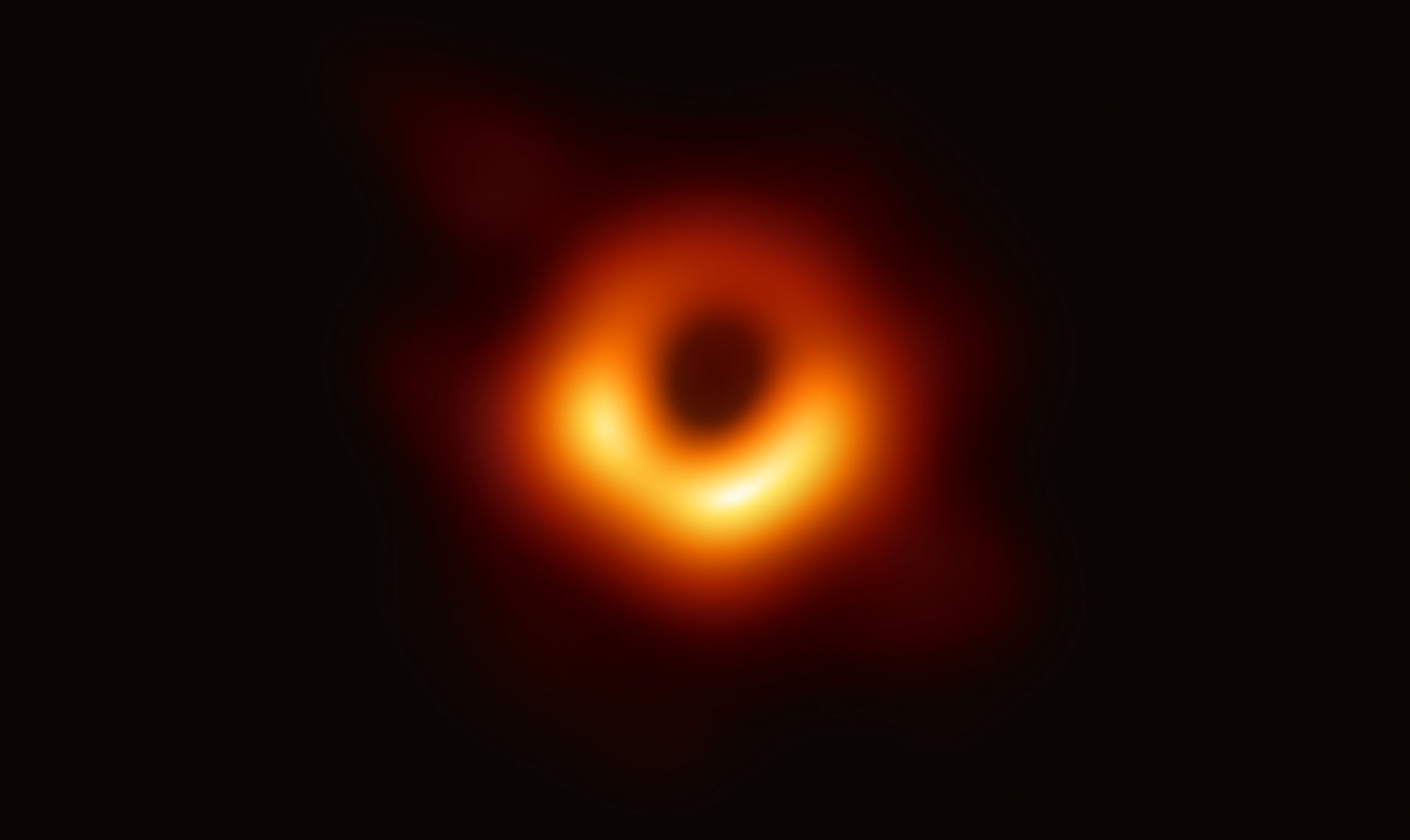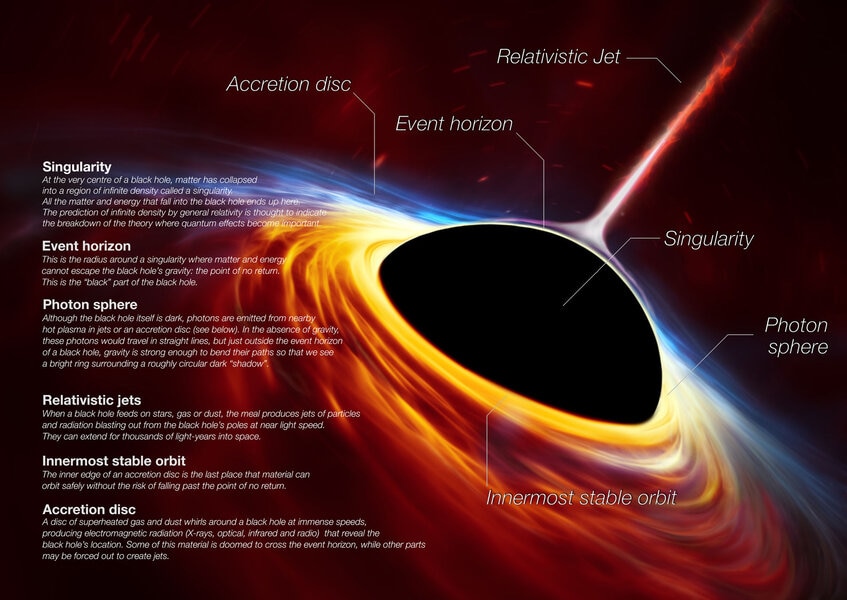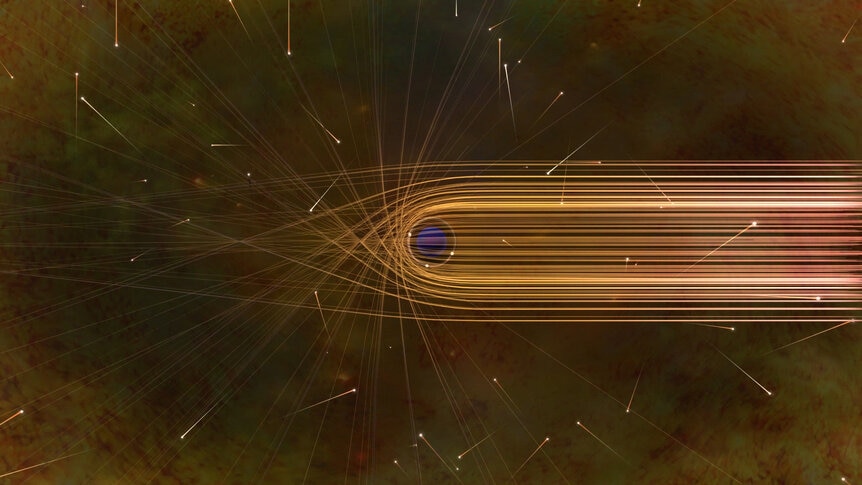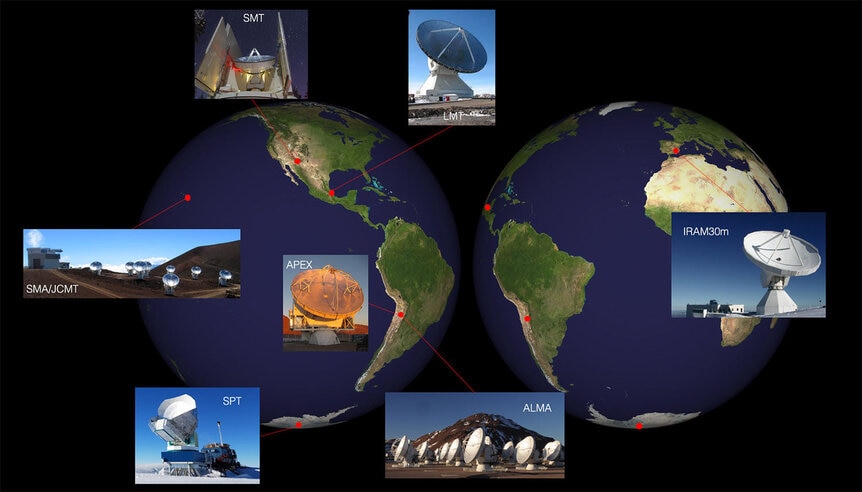Create a free profile to get unlimited access to exclusive videos, sweepstakes, and more!
Peering down the cliff of infinity: The first image of the event horizon of a black hole

For the first time in human history, astronomers have combined the power of telescopes from across our planet to create an image that shows the event horizon of a black hole.
The collected array is called the Event Horizon Telescope, and over the course of four nights in April 2017, it observed the supermassive black hole at the heart of M87, an elliptical galaxy in the Virgo cluster, 55 million light years from Earth.
What they saw is, well, jaw-dropping:
I want to be very careful here, as this image is a little more complicated than simply a ring of light with the black hole in the center, and the physics behind it is pretty fierce.
To be clear, you are not actually seeing the black hole itself. That circular hole in the center of the ring is not the black hole, but really an effect of its gravity. It’s being called the “shadow” of the black hole, but I think of it more as its cloaking device: The gravity is bending the light from the material around it, sending it toward us, leaving a gap where the black hole itself is. Perhaps the best way to describe it is as the silhouette of the black hole’s gravity.
This video should give you a handle on the effect:
To give you a sense of scale, the dark hole in the center is about 40 billion kilometers across. On average, Neptune is about 5 billion kilometers from the Sun, making this hole far, far larger than our solar system.
Yegads.
So, let’s back up a bit.
A black hole is an object with very intense gravity. The force of gravity you feel from an object depends on how much mass it has, and how far you are from it. If you take a big object like the Sun and squeeze it down, the gravity at its surface will get stronger. At some point the object gets so small that the gravity becomes incredibly strong, so strong that not even light can escape. Since light is the fastest thing in the Universe, this means nothing can escape it. It’s like an infinitely deep hole in space from which nothing gets out: a black hole.
This might help: My Crash Course Astronomy episode on black holes:
What you’re left with is a spherical region in space where inside it nothing can get out. The surface of this sphere, if you think of it that way, is called the event horizon (because any event that happens inside it is beyond your horizon, and cannot be seen). But just outside it, gravity is intensely strong but not impossibly so. A photon, a particle of light, passing near that limit but still outside it will have its path bent considerably, but it can escape.
The size of the event horizon depends on the mass of the black hole. If you do the math — first calculated by Einstein in the early 1900s — you’ll find that if you compress the Sun down to a black hole it would be 6 kilometers in diameter. Mind you, the Sun is 1.4 million km across now! So you have to make objects incredibly small and dense for them to become black holes.
We now think that every big galaxy in the Universe has a supermassive black hole in its center, with millions or even billions of times the mass of the Sun. The Milky Way has one that’s more than 4 million times the Sun’s mass, for example.
M87 is an elliptical galaxy in the heart of the Virgo Cluster, a collection of hundreds of galaxies spread across the sky between the constellations of Leo and Virgo. It’s a huge galaxy, bright enough to be seen using just binoculars, even though it’s 55 million light years away.
It’s also an active galaxy: Unlike the supermassive black hole in the Milky Way, the one in the center of M87 is actively gobbling down matter. Material, mostly gas and dust, is falling into it, and as it does it forms a flat disk called an accretion disk that starts just outside the event horizon and extends for many billions of kilometers. The speed it whirls around depends on its distance from the event horizon; stuff very close in moves very nearly at the speed of light, while stuff farther out is slower.
Since the material is rubbing together, it generates friction, and that in turn generates heat. A lot of heat. Like, a lot a lot. Imagine rubbing your hands together at the speed of light! The material in the disk gets heated to millions of degrees, and stuff that hot glows fiercely, emitting vast amounts of light.
That’s the material you see in the Event Horizon Telescope image*. This provides a background glow all around the black hole. But the gravity of the black hole distorts it, bending the path the light takes. Light from material behind the black hole gets bent around it, so we can actually see it! The closer to the black hole, the more it gets bent, until, right at the outline of the event horizon as seen from Earth, no more light can be seen. That’s why that part looks dark.
But wait! There’s more!
There’s an effect called relativistic beaming, caused by the incredibly rapid motion of the material as it orbits just outside the black hole. If you hold a light bulb in front of you, the light expands in a sphere, in all directions, But if that light bulb is moving near the speed of light, the light we see emitted from it appears to be beamed, like a flashlight, aimed into the direction it’s moving. This bizarre effect means that an object headed toward you at close to the speed of light appears brighter, because more of its light is focused toward you, and something moving away appears darker, because its light is focused away from you.
Now look again at the Event Horizon Telescope image. See how the stuff at the bottom of the ring is brighter than the stuff at the top? That’s due to relativistic beaming! The material at the bottom is headed toward us, and brighter than the material at the top, which is headed away from us. That tells us which direction the accretion disk is spinning. The black hole itself spins as well, in the same sense as the disk, so that also tells us that from our point of view, the black hole is spinning clockwise.
I won’t lie to you: When I first looked at that image and realized what I was seeing, the hair on the back of my neck stood up.
The technology that allowed astronomers to create this image is incredible. They used eight different telescopes located around the world — Arizona, Chile, Mexico, Spain, Hawaii, and Antarctica — to observe M87’s black hole. These telescopes don’t see optical light like our eyes, but instead are sensitive to light in the millimeter wavelength range, closer to radio waves than optical light. These millimeter waves travel at the speed of light (because they are light) and reach the telescopes at slightly different times. Each telescope carefully observes these waves, and if you combine that information it’s as if you have a virtual telescope the size of the space between the two observatories.
This is called interferometry. When you combine the waves seen at two locations, they constructively and destructively interfere with each other, creating fringes. It’s like when you slosh around in a bathtub; the crests of the waves sometimes add together and splash out the tub, while the troughs combine to drop the water level around you. Those combinations of crests and troughs are the fringes. In an interferometric telescope array, the information in all that can be turned around, worked backwards, to create an image of the image sending the waves to you. It’s fiercely complex work, and easier at longer wavelengths, which is why millimeter wave telescopes were used (optical light has a much, much shorter wavelength, and so optical interferometry is much more difficult).
When it’s all combined, the Event Horizon Telescope acts like a single dish the size of our planet. That’s how it could see any detail at all in the M87 black hole. Even though it’s immense, 40 billion kilometers across, it’s 55 million light years away, so from Earth it’s only about four billionths of a degree in size!
The Moon in the sky is half a degree wide, so this black hole image is equivalent to seeing a marble on the Moon. Or more accurately, a black marble with a glowing rubber band tied around it.
This is a phenomenal achievement, truly a new era in astronomy. We have seen the effects of black holes for decades: Material orbiting them and getting ferociously hot; beams of matter and energy shooting away from them as the ridiculously strong magnetic field in the accretion disk rips material off and flings it away at tremendous speed; and even the effects of our own galaxy’s supermassive black hole on stars around it, watching in real time as they whip around it at high velocity.
And we have delved into the physics of black holes thanks to the equations worked out by brilliant minds over many decades, learning how they distort space and time, what happens close to the event horizon, what happens outside it, and sometimes even working out what happens inside.
But this is the first time we’ve seen the event horizon of a black hole. And it’ll get better from here; more telescopes will be added to get better resolution, different wavelengths seen will squeeze more information out of what we’re seeing, and, even cooler, more black holes — including ours in the center of the Milky Way — will come under scrutiny this way.
Black holes are dark, but their future is very bright.
*Note: The Event Horizon Telescope did look at the black hole in the center of our galaxy as well, but it’s much more difficult to create an image of it due to how variable it is, changing its brightness on a scale of hours and days. The M87 black hole is more stable, so easier to image. By a quirk of geometry, it’s about 1,600 times bigger than “our” black hole, but about 2,000 times farther away, so it appears roughly the same size as ours from Earth.


















